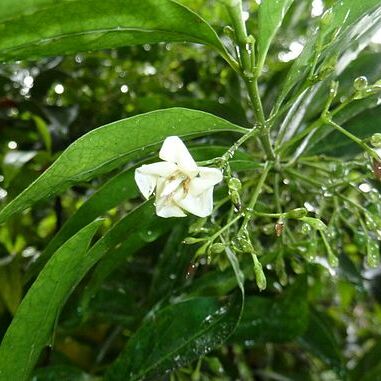It can be a low shrub on sand dunes or a tree up to 6 m high on better soils. The branches are long and flexible. The leaves are simple and opposite. They are smooth and thin. They can be 10 cm long and sword shaped. It has many flowers. The flowers are small and creamy-white. They occur in branching heads on long slender stalks. They have a small leafy growth at the base. The fruit are small and black when ripe. They are 8 mm across. They are edible.
Leaf blades 4–11.5 × 1.2–4 cm, elliptic, elliptic-ovate or oblong-elliptic, tapering to an acuminate or acute apex, rounded to cuneate at the base, glabrous but with pit-like domatia in the nerve axils beneath; petiole 1–5 mm long; stipules triangular, hairy inside with an apiculus 2–3 mm long.
Shrub or tree, up to 5 m high. Leaves elliptic, with domatia on lower surface, apex acute to acuminate, base cuneate to broadly cuneate. Cymes axillary. Calyx lobes almost free to base, triangular. Corolla throat hairy, tube 4 mm long, lobes 6-7 mm long. Fruit a drupe. Flowers white to cream.
Corolla creamy-white, rarely yellow; tube 3–4 mm long, 3–5 mm wide at top, funnel-shaped to campanulate; lobes 5–6.5 × 2.5–4 mm, rounded to obtuse.
Flowers in complicated dichasial cymes 2–3 cm long; peduncle 1.5–2 cm long; pedicels up to 9 mm long; bracts 2–3 mm long, folded, lanceolate.
Shrub or small tree 1–4(6) m tall with fairly smooth grey to brownish bark, glabrous.
Calyx lobes c. 1 mm long, triangular or ovate, obtuse to shortly acuminate.
Seeds 1 or 2 per locule, up to 7 mm long, hemispherical or segment-shaped.
Fruit purplish to black, 7–8 mm in diameter.


